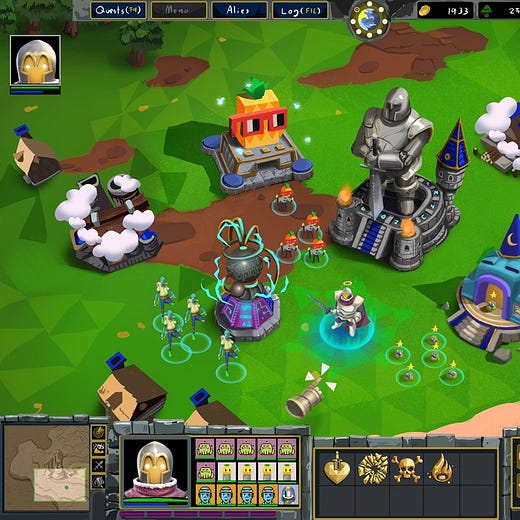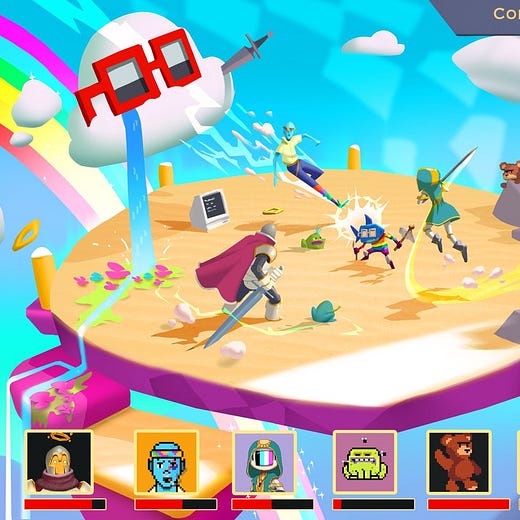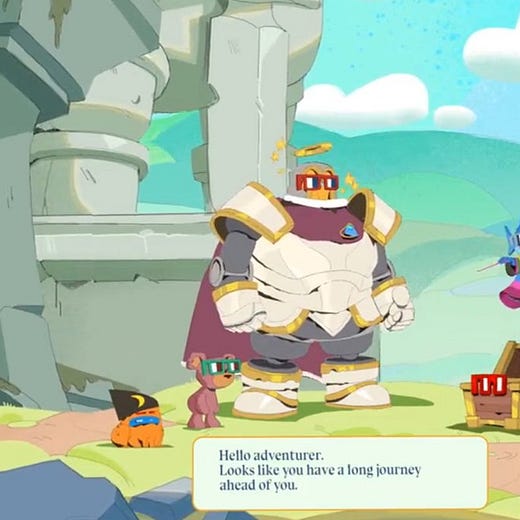NFT worldbuilding projects
Exploring new fictional universes being built around NFTs!
Metaversal is a Bankless newsletter for weekly level-ups on NFTs, virtual worlds, & collectibles
Dear Bankless Nation,
“Imagine Star Wars or Game of Thrones, but instead of being owned by Disney or HBO, the project is directly steered, developed and owned by a community of builders and creators and participants.”
That’s a quote by Timshel, the creator of The Genesis Project, a creative enterprise that’s now one of many building on and around Loot NFTs in what’s come to be known as the Lootverse.
Both the quote and the Lootverse point to a growing trend in the NFT ecosystem, namely community-centric or community-steered worldbuilding projects that are blooming out new fictional universes in decentralized fashion.
To me, worldbuilding communities are some of the most interesting things happening around NFTs right now, so let’s dive deeper and explore these efforts for today’s Metaversal.
-WMP
🙏 Sponsor: Brave Wallet - the secure crypto wallet. No extension required.✨
Creating new fictional worlds around NFTs

First, what is worldbuilding?
Worldbuilding is the art of creating a new fictional universe. It can be a solitary and literary act, like J. R. R. Tolkien’s genesis of The Lord of the Rings universe, or a collaborative and commercial affair, like the Marvel Cinematic Universe (MCU) transmedia franchise.

A collaborative but more experimental style of worldbuilding has lately cropped up around a handful of NFT projects whose communities are now working to create their own expansive fictional universes. Notably, NFTs allow community members to have direct presence and “digital real estate” in these universes in ways that haven’t been possible via traditional worldbuilding projects.
Cellarius as a forerunner experiment

“The Cellarius Universe (CX) is an original, transmedia cyberpunk franchise that leverages blockchain technology and user-generated assets to create a collaborative, fan-curated story.
Our narrative begins in the near future and will expand through the galaxy in both space and time. Written works, art, and other media will explore the relationship between humans, sentient artificial superintelligence, and the full spectrum in between. In essence, the Cellarius Universe is a future-oriented mythology. It is also a collective storytelling project whose content and contours will be shaped by its community.”
The paragraphs above read like the start of an announcement post for a contemporary NFT worldbuilding project, though they’re over 4 years old now!
That’s because the passages are the intro to the universe guide of Cellarius, a transmedia collaborative story effort that operated as a spoke of Ethereum venture studio ConsenSys between early 2018 and early 2019 before going bust. Cellarius was ahead of its time, as the crypto and NFT ecosystems were just too embryonic then to seriously support the project’s grand vision.
From my writerly POV, the foundational lore the Cellarius team had set up would’ve been (and still is) a great start for a collective storytelling effort. I highlight Cellarius here to show how contemporary NFT worldbuilding projects aren’t a brand new fad; instead, they’re tapping into deeper creative possibilities that have become more feasible in recent times thanks to crypto infrastructure advances and a surge of NFT experiments.
5 NFT worldbuilding projects to watch

Contemporary NFT worldbuilding projects come in different shapes and sizes. Some are totally in the public domain (CC0), while others don’t go so far. What these projects all share in common, though, is having communities that are actively working on building new fictional universes. Some examples are as follows.
The Lootverse

In Aug. 2021, dom created the text-based cryptoloot fantasy project Loot. The project exploded in popularity and rapidly captured the imaginations of many in the NFT ecosystem. Since then, a range of NFT projects have started building art, games, and beyond around Loot NFTs, and this has led to the organic formation of the Lootverse. The Lootverse has no central organizing force, but there are ongoing efforts to cultivate and develop its lore.
The Nouns universe
“Nouns is a protocol for proliferating Nouns,” as 4156 explained last year. The idea here is that of a virtuous cycle:
The protocol and generative Noun NFT avatars fund a treasury and attract innovators.
The Nouns DAO uses the treasury to fund the innovators who want to build on Nouns.
The apps and creations of the funded innovators attract more capital and more talented innovators, creating a virtuous cycle.
So while the Nouns project may not explicitly be a worldbuilding project per se, it’s a de facto one because the community’s drive to proliferate Noun culture has led to a boom of Nounish art, stories, poems, and more that are sowing the seeds for a vibrant Noun universe to come.
The Superverse
Spearheaded by dom and other talented NFT maestros, Sup is a creative studio that’s building out the Superverse, which contains the sci-fi CC0 universe project Blitmap, on-chain fantasy game console project Supdrive, and much more to come.
Notably, Sup is also currently exploring an experimental CC0-like “open world, owned likeness” licensing structure that’s worth keeping an eye on.
The Runnerverse
Chain Runners is another NFT worldbuilding project that’s been kickstarted around the collection’s 10,000 pixelated cyberpunk avatars. The Chain Runners community is working together to build and write out the Runnerverse, which to start centers around Mega City and its rebels’ fight against the enigmatic authority Somnus. Where the plot goes from there, though, will be steered by the community.
Yuga Labs’s Otherside?
Bored Ape Yacht Club creators Yuga Labs are slated to launch their Otherside metaverse project this month. The animated teaser for the project depicts non-Yuga NFTs like Cool Cats, CrypToadz, Nouns, and World of Women, so it’s clear the team has definite worldbuilding ambitions. However, until the Otherside is launched we can only speculate as to how this worldbuilding will look and how centralized of an effort it will be.
Zooming out
Worldbuilding projects are blooming around the contemporary NFT ecosystem, and in many cases these efforts are increasingly starting to bleed into one another. For example, consider how the HyperLoot project is exploring combining elements of the Lootverse with the Nouns universe and beyond. These sorts of NFT endeavors mark the beginning of what you can think of as the “Internet Cinematic Universe.”
Also, look for these sorts of worldbuilding projects to bring in new waves of creative users who are interested in more than just speculation. After I arrived as a creative in crypto in 2017, Cellarius was one of the “a-ha!” moments that really expanded and consolidated my interest in web3’s many possibilities. Contemporary NFT worldbuilding projects will have similar effects on others going forward, I guarantee it.
Action steps
🐂 Read The Bull Case for CC0 NFTs in Bankless
🦉 Check out my previous write-up March of the Moonbirds if you missed it + the new Bankless interview with Kevin Rose
Author Bio
William M. Peaster is a professional writer and creator of Metaversal—a Bankless newsletter focused on the emergence of NFTs in the cryptoeconomy. He’s also recently been contributing content to Bankless, JPG, and beyond!
Subscribe to Bankless. $22 per mo. Includes archive access, Inner Circle & Badge.
🙏Thanks to our sponsor
BRAVE WALLET
Brave Wallet: the secure crypto wallet, built directly into the browser.
Buy, store, send & swap assets. Manage NFTs. Connect other wallets & DApps. All from the security of the best privacy browser on the market.
Ditch those risky extensions. It’s time to switch to Brave Wallet.
Not financial or tax advice. This newsletter is strictly educational and is not investment advice or a solicitation to buy or sell any assets or to make any financial decisions. This newsletter is not tax advice. Talk to your accountant. Do your own research.
Disclosure. From time-to-time I may add links in this newsletter to products I use. I may receive commission if you make a purchase through one of these links. Additionally, the Bankless writers hold crypto assets. See our investment disclosures here.















I still think everyone is underestimating Yuga Lab's Metaverse.
They have the biggest backing and the best track record to date.
Gonna be be betting big.
genuine question: Why no blurb on FRWC? They're pretty world-buildy IMO. Do you consider FRWC in a whole different bucket of NFT project?
*not telling you how to run your blog. Just curious baout your thought-process.